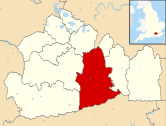Leatherhead
Leatherhead is a town in Surrey, England on the right bank of the River Mole, and at the edge of the contiguous built-up area of London. Its local district is Mole Valley. Records exist of the place from Anglo Saxon England. It has a combined theatre and cinema, which is at the centre of the re-modelling following late 20th century pedestrianisation. The streets bypassing the town centre close and feature in the annual London-Surrey cycle classic.
| Leatherhead | |
|---|---|
.jpg) Bridge Street, Leatherhead | |
 Leatherhead Location within Surrey | |
| Area | 12.54 km2 (4.84 sq mi) |
| Population | 11,316 (2011 census)[1] or 32,522 as to its Built-up Area which extends to Effingham[2] |
| • Density | 902/km2 (2,340/sq mi) |
| OS grid reference | TQ1656 |
| District |
|
| Shire county | |
| Region | |
| Country | England |
| Sovereign state | United Kingdom |
| Post town | LEATHERHEAD |
| Postcode district | KT22 |
| Dialling code | 01372 |
| Police | Surrey |
| Fire | Surrey |
| Ambulance | South East Coast |
| UK Parliament |
|
Just north-east of the midpoint of Surrey[n 1] and at a junction of ancient north–south and east–west roads, elements of the town have been a focus for transport throughout its history. A main early spur to this was the construction of the bridge over the seasonally navigable River Mole in the early medieval period.[3] Later the Swan Hotel provided 300 years of service to horse-drawn coaches. In the late 20th century the M25 motorway was built nearby. Leatherhead is typical of many towns which form part of the London commuter belt with many residents commuting daily into the capital.
Etymology
Leatherhead Museum has traced the history of the town's name back to AD 880 when it was recorded as Leodridan. The name was recorded in the Domesday Book as Leret and by the end of the 12th century it had been recorded as Lereda, Ledreda, Leddrede.[4]
Initially, the name was given an Anglo-Saxon derivation of lēod-rida ("place where people [can] ride [across the river]"), this is now considered highly unlikely as Lēod does not exist in any other English place-name, and *ride is speculation.[5] Richard Coates demonstrated a more plausible derivation from the Brythonic lēd-rïd (as in the modern Welsh "Llwyd rhyd" meaning 'grey ford'). This theory has been strengthened by further studies which suggest that the Anglo-Saxon form is a distorted of the original British name.[6][7]
History
Pre-1800
Within 2 miles (3.2 km) there is evidence of pre-historic and Celtic hillfarming on the North Downs to the east and south - the Druid's Grove, Norbury Park being a possible example of a place of pre-Christian pagan gathering. To the east of the town is the line of Stane Street, an old Roman road. Most of it is now built over or is used as woodland and hillside footpaths. The road leads from London to Chichester, passing through the strategic Mole Gap.
Landscape features including barrows beside the A246 provide evidence for a second late Romano-British road that ran for some miles from Stane Street in the east, close to Ashtead Church, crossing the Mole at Leatherhead Bridge, to approximately the present road junction very close to Effingham Church. Here it veered more true west and continued in another straight line to Merrow Church, crossing the River Wey near Guildford Bridge. The road existed by late Saxon times and all the medieval churches between Leatherhead and Guildford lie within a few yards of this route.[8]
The early settlement appears to have grown up on the east side of the River Mole: the site of an Anglo-Saxon burial ground is identified on the west side of the river at Hawk's Hill.[9] Ashtead lay within the Copthorne hundred by the formation of the Kingdom of England. Work on the parish church was started some time in the 11th century. Many parts were added over the years, with a major restoration taking place in the Victorian era.
Leatherhead appears in Domesday Book of 1086 as Leret. It was held by Osbern de Ow (Eu). Its Domesday assets were: 1 church, belonging to Ewell, with 40 acres (160,000 m2). It rendered £1. Pachesham within Leatherhead appears in Domesday Book as Pachesham. It was held by Hugo (Hugh) from the Bishop of Lisieux. Its domesday assets were: 3 virgates. It had part of 2 mills worth 12 shillings, 4 ploughs, 5 acres (20,000 m2) of meadow, woodland worth 3 hogs. It rendered a relatively low £3 10s 0d (£3.50) per year to its feudal system overlords.[10]
A market serving the developing agricultural economy developed at the crossroads and in 1248, Henry III granted to Leatherhead a weekly market and annual fair. The town survived an extensive fire in 1392, after which it was largely rebuilt. In common with many similar medieval towns, Leatherhead had a market house and set of stocks, probably located at the junction of Bridge Street, North Street and High Street.
.jpg)
The Running Horse pub dates back to 1403 and is one of the oldest buildings in Leatherhead. It is on the bank of the River Mole, at the southern approach to the town centre. History has it that Elizabeth I once spent a night at the inn when floods made the River Mole impossible to cross.
During the Elizabethan and Stuart periods, the town was associated with several notable people. Edmund Tylney, Master of the Revels, who was in effect the official censor of the time to Queen Elizabeth I, lived in Leatherhead's Mansion. A Wetherspoons pub in High Street is now named after him. Another notable local noble was Sir Thomas Bloodworth of nearby Thorncroft Manor, who was Lord Mayor of London during the Great Fire of London in 1666.
John Wesley, the founder of Methodism, preached his last sermon in Leatherhead on 23 February 1791.
1800 onwards
Leatherhead saw much expansion, with two major railways linked to it; see Transport.
In the 1870s, a group of clergymen built the private St John's School in the town, and it has produced a number of famous pupils. (See below).
The Letherhead Institute was built. The spelling was said, throughout much of Victorian times, to be the correct spelling.
Cherkley Court was a home of Max Aitken, 1st Baron Beaverbrook.
Modern era
Once parish industries included Ronson's Lighters and Goblin Vacuum Cleaners. Both were used as ammunition plants in the Second World War. Most of the assembly plants pulled out of Leatherhead in the late 1970s or early 1980s, in favour of commerce, transport and distribution.
In the 1940s and '50s Leatherhead/Ashtead was made home to a Remploy factory, which was designed to provide work for disabled people in the local area. On 22 May 2007, Remploy announced that the Leatherhead factory along with 42 other sites would close.
In the late 1970s and early '80s, Mole Valley District Council modernised the town, with a pedestrianised high street and a large one-way system.
In 1986, the town was joined to the UK motorway system, when the M25 motorway[11] was built to the north. Leatherhead became Junction 9, which has odd non-aligned entry/exit points on each side.
Local government
Leatherhead was an urban district until 1974. It is now part of Mole Valley District, with Dorking as the administrative centre of Mole Valley District Council. On the Mole Valley coat of arms, Dorking is represented by two cocks and Leatherhead by a swan. On the shield the wavy lines are for the River Mole, the acorns are for the district's three parks, and the points are for the North Downs.
The town
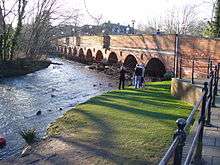
Landmarks
The symbol of Leatherhead is a swan holding a sword in its beak. This can be seen on the old Leatherhead coat of arms, and on the Mole Valley coat of arms. The insignia of Leatherhead Football Club includes a swan, as do the logos of the Swan Shopping Centre, Therfield School and the leisure centre.
Town centre
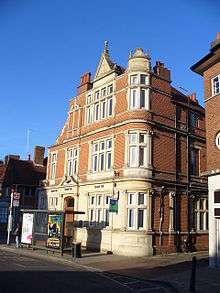
The town is above the river, and set away from the parks. Until the 1970s, it had many shops. However accidents occurred from increased traffic close to winding bends and narrow pavements. Since then the central streets have been pedestrianised or partly blocked off, leading to a decline in the number of pedestrians and shop closures in favour of out-of-town supermarkets. The construction of the Swan Centre and its supermarket, brought some revitalisation. In 2002, the high street was voted one of the worst in the United Kingdom in a BBC poll.[12]
The theatre (see below) is also a cinema and has art exhibitions. In the late 1990s the town centre's only hotel, the Bull Hotel, closed down and was subsequently demolished. A Lidl store was built on the site and opened in February 2007. Early in the 21st century, Travelodge opened a new hotel on the site of the old Swan Hotel.
North Leatherhead or Leatherhead Common
North Leatherhead or Leatherhead Common is the area north of the Kingston Road Bridge, bordered to the north by Leatherhead Golf Course, Ashtead Common and the M25 motorway and to the south by the railway which forks by the town centre. It includes the town's main secondary school, Therfield School, and part of the Trinity School, as well as the bulk of the town's social housing.
Here is the Royal Oak pub[13] and the North Leatherhead Community Association (NLCA) or social club in a former school building next to the Kingston Road Playing Fields and playground.
Local area
The villages of Fetcham and Mickleham may be considered part of Leatherhead, especially as a postal area. The border with Fetcham blends into Leatherhead. Ashtead is separated from Leatherhead by the M25. Also close by are Headley Heath, Oxshott Woods, Box Hill and Bookham Common.
In the village of Headley, a military hospital, Headley Court (formerly RAF Headley Court), provides long-term rehabilitation to injured members of the British Armed Forces. Its playing fields can be used by helicopters.
Economy
Leatherhead formerly had a number of light manufacturing businesses, such as the Ronson's lighter factory, but in and around the 1980s many closed or moved on. Recent years have seen the emergence of several industrial parks, and the town has attracted many service and headquarters operations, including well known companies.
The town has long been home to a cluster of research centres and research-focused businesses. ERA Technology Ltd is an engineering consultancy that has been in Leatherhead since the 1920s. Nearby is Leatherhead Food Research. The same area of west Leatherhead was home to the Central Electricity Research Laboratory (CERL), the main research lab for the CEGB until its dissolution in 2001.
A recently established local business cluster is that of racing cars. Lister Cars, makers of Lister Storm, Le Mans racing cars, are based in the town, and in nearby Dorking, while P1 International was founded here in 2000 by ex-Formula One World Champion Damon Hill.
The headquarters of Police Federation of England and Wales is based in Leatherhead.
Major local businesses
- AIRCOM International a provider of mobile telephone network management solutions has its headquarters in Randall's Research Park in Leatherhead.
- CGI (formerly Logica) has had several offices on different sites in the town[14] and is now on the Springfield Drive site.
- ERA Technology Ltd, a strategic business unit based in Leatherhead.
- ExxonMobil has several major divisions based at ExxonMobil House in Leatherhead, including its ExxonMobil Aviation and ExxonMobil Marine businesses, as well as its aviation fuels operations.[15][16]
- Halliburton Company has an office in Leatherhead, with its Landmark[17] based there.
- KBR has offices in Leatherhead, with its Granherne[18] subsidiary based there.[19]
- Robert Dyas, hardware chain is based in Leatherhead
- Unilever PLC has its UK and Ireland headquarters in Leatherhead at the purpose-built Unilever House - home to the following consumer brands: Bertolli, Cif, Colman's, Domestos, Dove, Flora, Hellmann's, Knorr, Lynx, Marmite, Persil, Radox, Sure, Surf, Toni & Guy, Tresemme, VO5 and Wall's ice cream.
Churches
- Church of Our Lady and St Peter, Leatherhead
- Church of St. Mary & St. Nicholas, Leatherhead
- Disciples Church (Calvary Chapel Leatherhead)[20]
Culture and sport
Theatre and cinema
Leatherhead's theatrical history dates from at least Tudor times. In 1890 the Victoria Hall opened in High Street and presented popular melodramas. In 1910, it was converted to a picture house, putting on the new "films", at first silent but later showing "talkies".
In 1939, the Crescent Cinema, with over 1,000 seats, was built in Church Street. Run by a local family, it prospered until the 1960s.
Two attempts in the late 1940s to reinvent the Victoria Hall as a theatre were unsuccessful. However the basement was converted to the "Green Room Club", and then in 1950 the theatre became home to the small "Under Thirty Theatre Group", who had good connections with the London theatre scene. Performances in the small building often featured leading actors and became increasingly popular, even as the building itself deteriorated.
Following a public fund-raising effort, September 1969 saw the opening by Princess Margaret of a replacement facility, the Thorndike Theatre, named after Dame Sybil Thorndike. Designed by Roderick Ham, the theatre was a complete 'cultural centre' whose radical open walkways and exposed concrete finish are thought to have influenced the later National Theatre in London.
For 30 years, the Thorndike Theatre maintained a reputation for high quality drama, and especially for presenting 'trial run' pre-West End shows. However, the theatre always struggled for funding, and closed in 1997. After four years of physical dereliction, it was taken over by a religious group.
Now, the Leatherhead Theatre is once again presenting regular drama and acting as a theatrical centre for the area.[21]
Leatherhead Drama Festival
Leatherhead Drama Festival began in 2004 and is the UK's largest drama festival of its type, in which schools and drama groups from around Surrey and beyond compete each year for the Sir Michael Caine Drama Awards, the Richard Houghton Awards and the 'Fire & Iron' New Writing Awards. Sir Michael Caine, patron of the festival, presents the awards, filming schedule permitting, at the Gala Awards Night each year.
Music
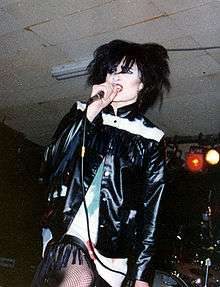
The band John's Children, which included sometime frontman Marc Bolan, was formed in the town in 1963 by Andy Ellison and Chris Townson, former pupils of nearby Box Hill School.[22]
Leatherhead secured a place in modern music history when, in 1974, producer Nigel Gray set up the Surrey Sound recording studios in a former village hall in the north of the town. Early demo pieces for, among others, the Wombles and Joan Armatrading were followed, from 1977, by the recording of much of the early repertoire of the Police. This included "Roxanne" and the band's debut album, Outlandos d'Amour; Reggatta de Blanc and its singles "Message in a Bottle" and "Walking on the Moon"; and the Grammy Award-winning Zenyatta Mondatta and its hit single "Don't Stand So Close to Me". In 1978, Godley & Creme recorded the first of five albums at Surrey Sound.
Subsequently, there were successful recordings at the studio by artists including Siouxsie and the Banshees, Rick Astley, the Lotus Eaters, Alternative TV and Bros. With Gray's brother Chris as engineer, Surrey Sound initially had a four-track capability but upgraded to 16-track in 1977 and to 24-track a year or two later. It was sold by Gray in 1987.
Less influentially, in 1980, local band the Head released the punk rock single "Nothing to Do in a Town Like Leatherhead".
Leatherhead Football Club
There is a local football team Leatherhead F.C. ("The Tanners") who play at Fetcham Park Grove. In the 1974–75 season the Tanners were drawn against First Division Leicester City at home in the FA Cup Fourth Round Proper. With the game switched to Filbert Street, the BBC's Match of the Day cameras and over 32,000 people saw a dramatic match: Leicester won 3–2. Leicester City went on to play Arsenal in the next round. In the 2017–18 FA Cup they reached the second round proper where they were tied away to Wycombe Wanderers.
Local leisure and entertainment
The leisure centre was built in the 1970s, and is owned by Mole Valley District Council and managed by Fusion Lifestyle.
The centre was extended in the 1980s with the Mole Barn. Plans to build a new centre on the site were drawn up by Mole Valley District Council prior to 2006, but instead the facility was given a 20-month, £12.6m refit and further extension, reopening (ten months late) in March 2011. The upgraded centre includes: a redesigned reception and entrance area, a 400 m2 gym with around 90 cardiovascular machines and a large free-weight area; an aerobics studio; a Multi Use Games Area (MUGA); a 400 m2 soft play facility for children; a creche; and two new squash courts.[23][24][25]
Bockett's Farm off Young Street has rare breeds and a petting zoo. It is open to the public almost all year round, and local schools use the farm for teaching and day trips.
Education
State schools
Private schools
- Downsend School, close to Ashtead
- Downsend Lodge Leatherhead, part of Downsend School
- St John's School
- West Hill School
Transport
Taxis
- A taxi rank is located at Leatherhead railway station and is accessible from the southbound platform. There is also a taxi company called Mole Valley Premier which is situated on North Street.
Rail
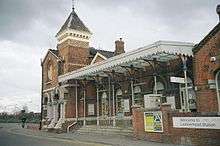
Leatherhead is served by Leatherhead railway station. Over the years, however, Leatherhead has had four railway stations, two of which were only temporary and survived for about eight years from the railway's first opening in 1859. The current and only surviving station was designed by C. H. Driver in fine gothic revival style. It opened in 1867 to serve the London Brighton and South Coast Railway line to Dorking. The remains of the second London and South Western Railway railway station can still be seen on the Leatherhead one way system. It was built as a separate terminus, but became a through station when the line to Effingham Junction and Guildford was opened in 1885. It was closed in July 1927. The lines were electrified by the Southern Railway in 1925.
Services included trains northwards to London Waterloo, London Victoria, Epsom, Sutton and Wimbledon where it connects with the London Underground and Tramlink, and south to Dorking, Horsham, Guildford.
Road
- The main London to Worthing road, the A24, runs through the edge of town being part of its bypass, to the east.
- The M25 motorway lies to the north of the town, with Leatherhead being accessed via Junction 9.

Emergency services
Leatherhead is served by these emergency services:
- Surrey Police. Dorking Police Station.
- South East Coast Ambulance Service as of 1 July 2006, is the local NHS Ambulance Services Trust.
- Surrey Fire & Rescue Service, station just inside Fetcham, but called Leatherhead Fire Station manned by a full-time crew.
The hospital A&E for the Leatherhead area is at Epsom Hospital.
Notable people
- Harold Auten VC DSC (1891–1964), recipient of the Victoria Cross during the First World War, was born in Leatherhead.[28]
- John Drinkwater Bethune (1762–1844) lived at Thorncroft Manor just outside the town from about 1838 until his death and is buried in the churchyard of the parish church.
- Sir Thomas Bloodworth (1620–1682), Lord Mayor of London during the Great Fire of 1666, owned and lived at nearby Thorncroft Manor.
- Ted Bowley (1890–1974), English Test cricketer.
- Michael Caine (born 1933), lives in Leatherhead and is patron to the Leatherhead Drama Festival.[29]
- Donald Campbell (1921–1967), Bluebird pilot and fastest man on land and water, lived in Leatherhead.[30]
- John Campbell-Jones (born 1930), former Formula One racing driver.
- Leonard Dawe (1889–1963), footballer, teacher and crossword compiler for the Daily Telegraph; while living in Leatherhead in 1944 he was wrongly suspected of espionage by inserting codewords for Operation Overlord into his puzzles.
- Admiral Sir John Thomas Duckworth (1747–1817), accomplished Royal Naval officer who served under Nelson.
- Andy Ellison (born 1946) and Chris Townson (1947–2008), founding members of the band John's Children, and former pupils at Box Hill School.
- Badri Patarkatsishvili collapsed and died in his mansion in Leatherhead.
- Richard Patterson (b. 1963) and his brother Simon Patterson (b. 1967), both artists, were born in the town.
- Jean Ross (1911–1973), an English writer was educated in Leatherhead and briefly confined in a nearby sanatorium as a young woman.[31]
- Madron Seligman (1918–2002), Member of the European Parliament and friend of Edward Heath.
- Marie Stopes (1880–1958), family planning pioneer, lived in the town.[30]
- Edmund Tilney (c. 1536–1610), Master of the Revels to Queen Elizabeth I, lived in the Mansion House. The Master of the Revels was in effect the official censor of the time. All of William Shakespeare's work would have passed his eyes before going public, the local Wetherspoons pub is now named after him.
- Edward Wilkins Waite (1854–1924) was a noted local landscape painter.
- Roger Waters (born 1943) Musician/songwriter/composer; vocalist and bassist of the famous English rock act, Pink Floyd.
- John Wesley preached his last sermon in Leatherhead on 23 February 1791, delivered at the top of Bull Hill when he was 88.[30]
Fictional references
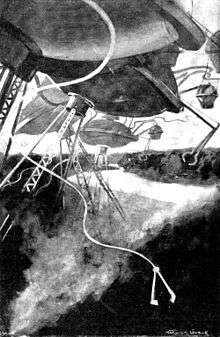
- H. G. Wells's novel The War of the Worlds features Leatherhead. On about the tenth day following the Martian invasion of Earth, the entire town (where the narrator has sent his wife for safety) is obliterated: "it had been destroyed, with every soul in it, by a Martian. He had swept it out of existence, as it seemed, without any provocation, as a boy might crush an ant-ill, in the mere wantonness of power."[32]
- In the TV series The Hitchhiker's Guide to the Galaxy, the house that was used as Arthur Dent's residence is in Leatherhead.
- The film I Want Candy (released 23 March 2007) has the tagline: "Two lads from Leatherhead are making a movie...and it's all gone pear-shaped". However, the film is not set in Leatherhead.
- That Mitchell and Webb Look took a jab at Leatherhead in series two, episode four. In it, a librarian comments to a customer that she is "possibly one of the stupidest people I've ever met. And I lived in Leatherhead for six miserable years."[33]
- Monty Python's Flying Circus makes reference to Leatherhead in the "Red Indian in Theatre" sketch, when Eric Idle, in Native American costume says, "When moon high over prairie, when wolf howl over mountain, when mighty wind roar through Yellow Valley, we go Leatherhead Rep - block booking, upper circle - whole tribe get it on three and six each."
- Robyn Hitchcock refers to Leatherhead in the song "Clean Steve," immediately before the key change.
- The video game Sherlock is partially set in Leatherhead.
Demography and housing
| Ward | Detached | Semi-detached | Terraced | Flats and apartments | Caravans/temporary/mobile homes/houseboats | Shared between households[1] |
|---|---|---|---|---|---|---|
| Leatherhead North | 307 | 906 | 575 | 1,381 | 6 | 2 |
| Leatherhead South | 737 | 331 | 171 | 670 | 4 | 4 |
The average level of accommodation in the region composed of detached houses was 28%, the average that was apartments was 22.6%.
| Ward | Population | Households | % Owned outright | % Owned with a loan | hectares[1] |
|---|---|---|---|---|---|
| Leatherhead North | 7,035 | 3,177 | 19 | 31 | 617 |
| Leatherhead South | 4,281 | 1,913 | 44 | 30 | 637 |
The proportion of households who owned their home outright compares to the regional average of 35.1%. The proportion who owned their home with a loan compares to the regional average of 32.5%. The remaining % is made up of rented dwellings (plus a negligible % of households living rent-free).
Notes and references
- Notes
- i.e. referring to Surrey's reduced, current, semi-rural version. In this historical definition, Leatherhead was just south-west of its centre.
- Established in 2006 from the merger of Woodville School, St Mary's School and All Saints School.
- References
- Key Statistics; Quick Statistics: Population Density United Kingdom Census 2011 Office for National Statistics Retrieved 20 December 2013
- https://www.nomisweb.co.uk/reports/localarea?compare=1119885198
- "History". Mole Valley District Council. Archived from the original on 8 July 2009.
From the construction of the bridge over the River Mole in the early medieval period
- Ekwall, E. (1940) The Concise Oxford Dictionary of English Place-names; 2nd ed. Oxford; Clarendon Press; p. 279
- Gover, J.E.B., A. Mawer and F.M. Stenton, with A. Bonner. 1934. The place-names of Surrey. Cambridge: Cambridge University Press (SEPN vol. 11).
- "Archived copy" (PDF). Archived from the original (PDF) on 9 November 2006. Retrieved 9 November 2006.CS1 maint: archived copy as title (link)
- Richard Coates, 'Methodological Reflexions on Leatherhead', Journal of the English Place-Name Society, 12 (1979–80), 70–74.
- H.E. Malden, ed. (1911). "Parishes: Effingham". A History of the County of Surrey: Volume 3. Institute of Historical Research. Retrieved 28 December 2013.
- R.A. Smith, 'Recent and former discoveries at Hawks Hill', Surrey Archaeological Collections XX (1907), pp. 119-28.
- "Surrey Domesday Book". Archived from the original on 15 July 2007.
- "Motorway Database M25 and A282 Timeline". CBRD. Archived from the original on 3 February 2011.
- "Britons name 'best and worst streets'". BBC News.
- "royaloak.org.uk". Archived from the original on 28 May 2007.
- "Information technology and business process outsourcing - CGI IT services".
- "Contact our business headquarters - ExxonMobil". ExxonMobil.
- "Aviation". ExxonMobil.
- "Landmark". Archived from the original on 3 December 2013.
- "Granherne".
- "Archived copy". Archived from the original on 8 January 2009. Retrieved 14 January 2009.CS1 maint: archived copy as title (link)
- "Disciples Church". Disciples Church.
- "Archived copy". Archived from the original on 11 September 2009. Retrieved 16 August 2009.CS1 maint: archived copy as title (link)
- John's Children official site
- "beecareful.info".
- "Leatherhead Leisure Centre revamp nears completion". BBC News.
- Charlie Mole. "Duke of Kent to open £12.6m leisure centre". Your Local Guardian.
- "Fetcham Village Infant School - Home".
- oakfieldjunior.ik.org Archived 26 June 2007 at the Wayback Machine
- "VC BURIALS - USA".
- "Archived copy". Archived from the original on 4 June 2009. Retrieved 17 October 2009.CS1 maint: archived copy as title (link)
- "Visit Leatherhead".
- Parker, Peter (September 2004). "Ross, Jean Iris (1911–1973)". Oxford Dictionary of National Biography. Oxford University Press. doi:10.1093/ref:odnb/74425. Retrieved 18 June 2017.CS1 maint: ref=harv (link)
- H.G. Wells, The War of the Worlds, Book II, Chapter 9.
- "That Mitchell and Webb Look (2006) s02e04 Episode Script | SS". Springfield! Springfield!. Retrieved 29 February 2020.
External links
| Wikimedia Commons has media related to Leatherhead. |
- Mole Valley District Council
- Leatherhead Residents Association
- Leatherhead Local History
- . Encyclopædia Britannica (11th ed.). 1911.
